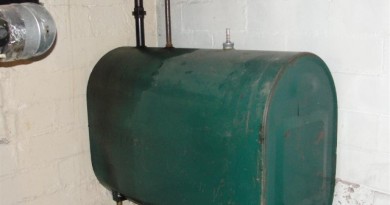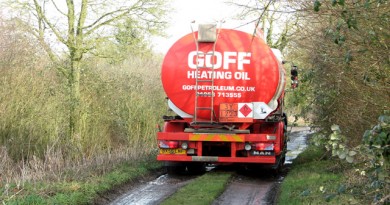How Much Does A Geothermal Heat Pump Cost?
A heat pump is a central heating system that moves heat from one place to another. In a typical system, there is an indoor unit with an evaporator coil, and an outdoor unit called a condenser. The refrigerant is a safe and unreactive chemical that changes between a liquid and a gas. In a heat pump, the condenser extracts heat from the outside and uses the refrigerant to move that heat into the home. This works even on a cold day because even cold air contains some heat until the air reaches -200 degrees Fahrenheit.
On extremely cold days – the current United States record is -70 degrees – the heat pump has to work very hard to extract heat from the air. This results in a greater use of energy and high utility bills. Geothermal heat pumps combat this by being underground, where the temperature is surprisingly uniform year round. Instead of exchanging heat with the outside air, it exchanges with the ground. The temperature 20 feet below the ground remains at a fairly constant 50 degrees to 60 degrees Fahrenheit. Studies indicate that 70% of the energy used by geothermal heating and cooling is renewable energy from the ground, making the geothermal heat pump one of the most efficient home heating systems available.
Geothermal Heating And Cooling Cost
This information about the energy efficiency of geothermal heat pumps should by now have you asking “how much does geothermal energy cost?” Geothermal heat pump cost is initially higher than a regular heat pump, but the energy savings are rather significant. The U.S. Environmental Protection Agency states that an energy bill can be lowered by as much as 30% to 40% with geothermal heating and cooling. Savings from geothermal heating cost pile up fast and will eventually cover the geothermal heat pump price. The U.S. Department of Energy states that the savings in geothermal heating cost will cover the geothermal system cost in 5 to 10 years. Energy Star qualified pumps qualify for a tax credit up to 30% of the cost, including installation and labor. There is no upper limit to this credit.
Geothermal Heat Pump Price
Geothermal heat pump price can be $3500 for the unit alone. The more expensive varieties have added options such as a water heater and a two stage compressor. With these added options, geothermal heat pump cost rises to around $7500. These prices do not include labor. Excavation and installation raises geothermal heat pump cost to between $10,000 and $25,000. The variation is due to the depth the unit will be installed in and the soil conditions. Installation can take from 1 to 3 days, largely depending on how deep the unit is to be installed. Holes for installation are typically dug 150 feet to 250 feet deep.
Residential Geothermal Heat Pump Cost
When calculating the savings from installing a geothermal heating and cooling system, what you are looking to cover is not the entire geothermal heat pump price plus installation but the difference between geothermal heat pump cost and a regular heat pump. You also need to take into account the federal Energy Star tax credit as well as any rebates that might be available to you from your local utility company. Installation of a regular heat pump is about $5000 with existing duct work, which is four to five times less than for a geothermal system. That difference in price should be paid for in five to ten years from the energy savings you will experience.
Geothermal Heat Pump Installation Cost
The total geothermal heat pump price will be affected by the labor required for excavation and installation. This is not considered a do it yourself project. Professional installation is most certainly required, as mistakes can negatively affect the energy efficiency of the system. Installation costs are affected by the condition of the ground, and the depth of the installation. Soft soil will be easier to excavate than bedrock, affecting the installation cost substantially. Because of the high cost of installation, most people choose to finance the project with an energy efficiency mortgage or energy improvement mortgage. The mortgage industry offers this product to cover the cost of a geothermal heat pump because they know that the energy savings are significant enough to free up money to help pay off the individual’s mortgage.
Geothermal Heat Pump Manufacturers
Most all air conditioning and heating manufacturers also sell geothermal heating and cooling systems. The ultra-efficient Trane XL20i heat pump can cost from $8500 to $16,000 installed. The cost for this Trane geothermal heat pump by itself is from $3500 to $7500 depending on the size. The ClimateMaster TT-038 Tranquility 27 2-Stage Heat Pump costs $23,000 installed. Tax credits and utility rebates can lower the cost of this Climatemaster geothermal heat pump to just over $21,000 or less. Carrier’s GT-PX Geothermal Heat Pump costs about $7,000. The Carrier geothermal heat pump is one of the highest rated units available.
Geothermal Heat Pump Tax Credit
Geothermal heating cost savings are so substantial that the U.S. government recently changed the available tax credit for purchasing a geothermal heating and cooling system. Formerly capped, as of the Economic Stimulus Recovery Act of 2009 there is no longer a limit on the 30% tax credit for the installation of a qualified geothermal heat pump. There are local tax credits available as well, and most local utility companies provide a rebate to help you pay for the system. Information on these incentives is available from the Database for State Incentives for Renewables and Efficiency.
Geothermal Pros And Cons
A geothermal heat pump can be prohibitively expensive for some. No matter the savings, some people might not be in a position to be able to pay for the initial cost of installation. They also might not have the credit rating for a loan or mortgage to pay for the system. Depending on your local terrain, installation might be too expensive. But if you can afford the cost of installation, there are many benefits. The technology is too new to offer reliable data as to its lifespan, but most units installed 25 years ago are still operating well with little to no maintenance required. The energy savings are substantial, as is the positive impact on the environment.
- 803SHARES






